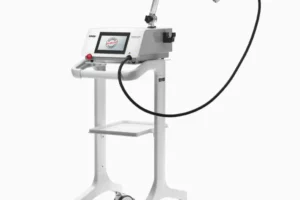[vc_row][vc_column][ultimate_video u_video_url=”https://www.youtube.com/watch?v=-g8JIy2hRbw” yt_autoplay=”” yt_sugg_video=”” yt_mute_control=”” yt_modest_branding=”on” yt_privacy_mode=”” play_size=”75″ enable_sub_bar=””][vc_column_text]
Pronation is a term that most experienced runners will be familiar with, referring to the action whereby the foot rolls inward for impact distribution when landing.
Naturally, it’s a word which has been heavily linked to running due to the regular and consistent impact that each foot undergoes.
It has commonly been understood that pronation or supination (an outward roll of the foot) can put someone at higher risk of running-related injuries. It’s been largely communicated to the fitness & wellbeing community that pronation is ‘bad’ and should be corrected, with many large high street sportswear brands still advising customers to choose their fitness footwear in response to pronation or supination.
[/vc_column_text][vc_column_text]
Is pronation really that important?
Recent studies have suggested that this could be incorrect and that foot pronation is in fact a natural movement which in most cases, has little to no impact on your fitness schedule and does not need to be ‘fixed’.
Our Clinical Director, Emily Ball & Podiatrist Jim Davies discuss the reasons why pronation doesn’t need to influence your next fitness footwear purchase and the things you should be thinking about when buying new running shoes.[/vc_column_text][vc_row_inner content_placement=”middle”][vc_column_inner width=”1/4″ offset=”vc_hidden-xs”][vc_single_image image=”14259″ img_size=”full” el_class=”img-circle-blue”][/vc_column_inner][vc_column_inner width=”3/4″][ultimate_heading main_heading=”“Pronation, first and foremost, is a completely natural movement and 99.9% of humans on the planet pronate. In the foot, this is our body’s way of bracing for impact and there is no defined ‘right’ amount for the average person. The idea that more or less pronation is inherently bad for training and lower leg health is something which has been perpetuated by running shoe companies, rather than medical professionals”” heading_tag=”h3″ alignment=”left” main_heading_style=”font-style:italic;” main_heading_margin=”margin-bottom:15px;”]
Jim Davies BSc (Hons)
Podiatrist
[/ultimate_heading][/vc_column_inner][/vc_row_inner][vc_column_text]
Labelling a foot condition as ‘bad’ can be harmful.
While we don’t believe it is the intention of sports footwear retailers to mislead their customers, it’s also important to note that labelling a condition as ‘bad’ can be a harmful practice. Often this can play on someone’s mind and make them believe that they need to take steps in order to change this, which ultimately has an overall impact on their training schedule.[/vc_column_text][vc_column_text]
There’s no evidence that mild pronation puts you at a higher risk of injury
Mild pronation or supination appears to be mostly harmless, according to several recent studies into the condition and how it affects us.
Interestingly, there is a limited amount of evidence which suggests that structured running shoes, designed and pitched for help with pronation correction, actually do not make any difference to the natural roll of a person’s foot. Despite a particular brand’s claims, pronation can and does still take place within the shoes themselves.[/vc_column_text][vc_column_text css=”.vc_custom_1655999727502{margin-top: 30px !important;border-top-width: 1px !important;border-bottom-width: 1px !important;padding-top: 20px !important;padding-bottom: 20px !important;border-top-color: #a60d33 !important;border-top-style: solid !important;border-bottom-color: #a60d33 !important;border-bottom-style: solid !important;}”]Read More: Foot Mobilisation at Active Step[/vc_column_text][vc_column_text]
Seek professional advice rather than reaching for new shoes
If pronation or supination is more severe, it can cause pain or discomfort and lead to injuries whilst training. If this is something you’re experiencing, the best option is always to seek professional advice. A foot care professional can properly assess your pronation and offer tips & treatment options to help you get the most out of your running and avoid foot-related injuries.
While new shoes can be an exciting purchase for avid runners, your decision to buy new shoes should be based on fit and comfort, rather than trying to ‘correct’ your natural foot pronation. If the running shoes you have at the moment are comfortable and in good condition, there’s no reason to change them![/vc_column_text][vc_row_inner content_placement=”middle”][vc_column_inner width=”3/4″][ultimate_heading main_heading=”“We see an awful lot of runners as patients at Active Step and the most common cause of injury is actually training error and taking on too much too soon. It’s very common, however, for patients to believe that their injuries are a direct result of the footwear they are using whilst training.”” heading_tag=”h3″ alignment=”right” main_heading_style=”font-style:italic;” main_heading_margin=”margin-bottom:15px;”]
Emily Ball BSc (Hons) FFPM RCPS (Glasg)
Managing Director
[/ultimate_heading][/vc_column_inner][vc_column_inner width=”1/4″ offset=”vc_hidden-xs”][vc_single_image image=”14258″ img_size=”full” el_class=”img-circle-red”][/vc_column_inner][/vc_row_inner][/vc_column][/vc_row][vc_row css=”.vc_custom_1655833080953{padding-top: 40px !important;padding-bottom: 80px !important;}”][vc_column][vc_column_text]
So, what is the final word on pronation?
Ultimately, the myths surrounding pronation in relation to runners and their training has mostly been influenced by the running industry, rather than health & foot care professionals. This has led to consumers seeking a quick fix for their injuries and often means that those who do sustain injuries are not getting to the true source of their issues.
If you’d like to understand more about your own pronation as well as finding out how your body responds to running training and the technique alternations you should be making, book a professional assessment with one of our highly experienced team. Likewise, if you have recently sustained a running related injury or are prone to injuries in sport, we would strongly advise booking an assessment to understand the root cause of these issues and work towards effective rehabilitation that suits your needs and training programme.[/vc_column_text][/vc_column][/vc_row][vc_row full_width=”stretch_row” equal_height=”yes” bg_type=”bg_color” css=”.vc_custom_1655224217930{margin-right: 0px !important;padding-right: 0px !important;}” bg_color_value=”#2b3685″][vc_column width=”2/5″ css=”.vc_custom_1655224256239{padding-top: 30px !important;padding-bottom: 30px !important;}”][ultimate_heading main_heading=”Give Your Feet an MOT” alignment=”left” el_class=”text-light” main_heading_margin=”margin-bottom:30px;” sub_heading_margin=”margin-bottom:20px;”]Our MSK Assessments offer in-depth analysis of your gait and mobility of the full lower body, giving you a foundation of knowledge to improve your running technique. Our expert podiatrist team will help you meet any mobility goals you have, as well as provide a wealth of resources to improve your foot health and comfort in every situation.[/ultimate_heading][dt_default_button link=”url:https%3A%2F%2Factive-step-healthcare-ltd.au1.cliniko.com%2Fbookings%3Fbusiness_id%3D30903%26appointment_type_id%3D128225|title:MSK%20and%20Gait%20analysis” size=”big” button_alignment=”btn_left”]Book An MSK Appointment[/dt_default_button][/vc_column][vc_column width=”3/5″ css=”.vc_custom_1655224738577{background-position: center !important;background-repeat: no-repeat !important;background-size: cover !important;}”][vc_row_inner][vc_column_inner width=”1/3″][vc_single_image image=”14256″ img_size=”full”][/vc_column_inner][vc_column_inner width=”1/3″][vc_single_image image=”14254″ img_size=”full”][/vc_column_inner][vc_column_inner width=”1/3″][vc_single_image image=”14255″ img_size=”full”][/vc_column_inner][/vc_row_inner][/vc_column][/vc_row]



